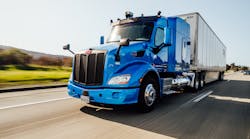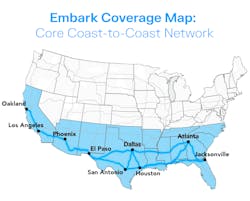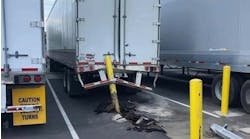Autonomous technology company Embark Trucks launched the coast-to-coast backbone of its Embark Coverage Map, which it said would prepare U.S. Sunbelt markets to be served by Embark fleet partners.
The Coverage Map includes nine transfer point sites in cities across the southern U.S., including new locations in Dallas, El Paso, Atlanta, and Jacksonville, Florida, to accommodate planned autonomous freight volume in those markets and provide anticipated operational support for carriers and shippers using Embark-powered trucks.
"Our carrier partners have a meaningful portion of their loads concentrated on a select set of lanes between major markets in the Sunbelt," said Embark CEO Alex Rodrigues. "We are delivering on one of our key 2022 objectives by activating these key markets as one cohesive network today, giving carrier partners the line of sight they need to plan their deployment of Embark-equipped trucks, improving the ecosystem’s ability to rapidly scale in 2024.”
Embark acquired real estate and support services through its partnerships with Alterra Property Group and Ryder. The Coverage Map expansion represents the next step to deliver coast-to-coast operational availability that began with Embark’s first Los Angeles to Jacksonville run in 2018.
Embark strategically selected these nine sites to eventually automate crucial shipping lanes for its carrier partners, according to the announcement. The expanded network that Embark is positioned to serve through these nine sites covered 9.5 billion miles of annual freight in 2020, including Dallas to Houston, San Antonio to Houston, and Dallas to Atlanta—some of the highest-volume inter-city lanes in the nation. As a result, by opening these nine sites, 28% of U.S. shipping volume in the Sunbelt is available for autonomous transport by Embark’s fleet partners, which will be able to own and operate the trucks and begin hauling goods autonomously once Embark’s technology is commercialized.
By operating autonomously across the network, Embark’s carrier partners should be able to deliver faster because of its 24/7 operations. More than 40% of U.S. shipment miles in the expanded Coverage Map are on lanes that are longer than drivers can complete in a single shift due to hours-of-service regulations. Embark anticipates that the 3.3 million loads on these lanes should become eligible for earlier delivery once its operations are fully automated.
In delivering this core segment of the Embark Coverage Map, Embark leveraged partnerships to accelerate deployment timelines, access superior properties for autonomous trucks, and deliver infrastructure for fleet partners in an asset-light manner. In working with Alterra, Embark was able to leverage Alterra’s industry knowledge and team providing nationwide coverage, its portfolio of more than 150 existing properties across 30 states, and its fully discretionary fund, to quickly identify sites and structure flexible usage agreements that enable Embark to scale across specific properties in alignment with the company’s growing volumes. As Embark builds density across the Embark Coverage Map, the company said it would look to expand to additional sites and leverage other utilization structures, such as pay-per-use, as operations continue to scale.
Today, the Embark Coverage Map is being used in conjunction with Embark’s fleet partners through multiple pilots. To support fleets operating on the network, Embark, through a long-standing partnership, has deployed Ryder operators to certain Embark Coverage Map sites to provide inspections and support services necessary to keep trucks moving in an efficient and safe manner.
Embark's proprietary, patent-pending Vision Map Fusion (VMF) technology is positioned to allow for this rapid coast-to-coast expansion. VMF minimizes reliance on cumbersome HD maps by instead leaning more heavily on real-time inputs from Embark’s sensor suite, allowing the technology to navigate its environment utilizing a light and easy-to-create and -maintain map. This map-light approach allows Embark to expand to new markets in a way where effort does not scale with the mileage.




